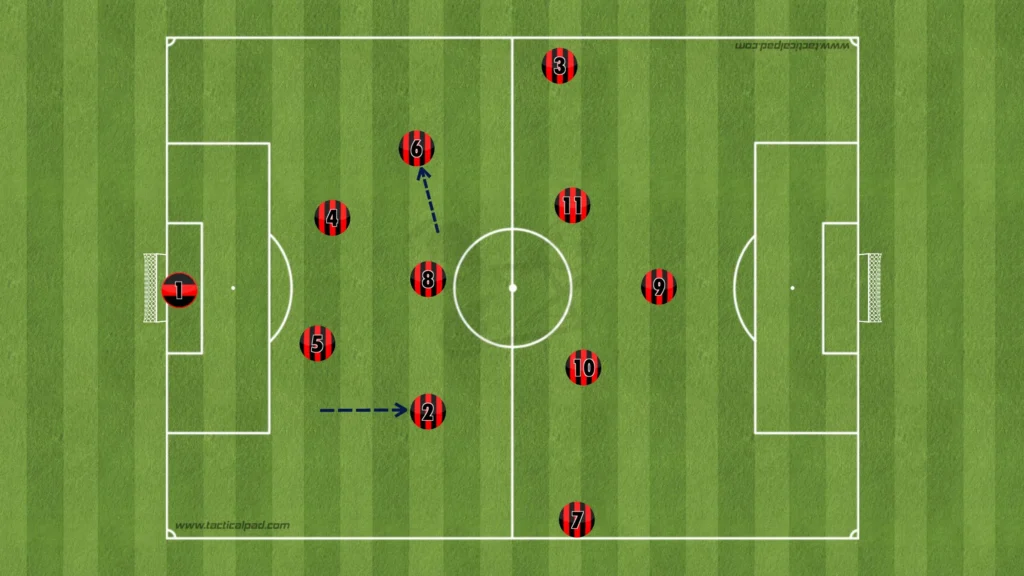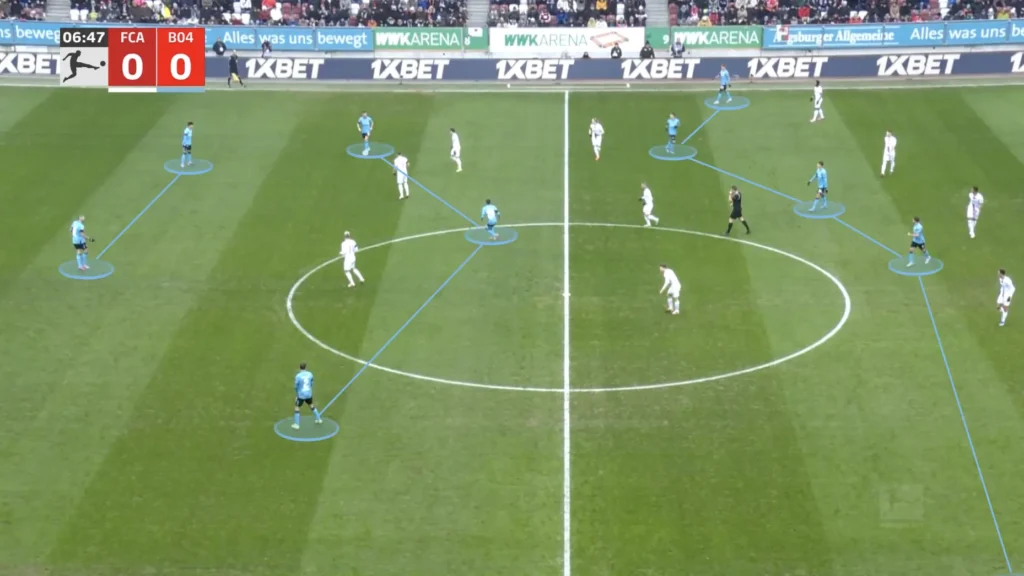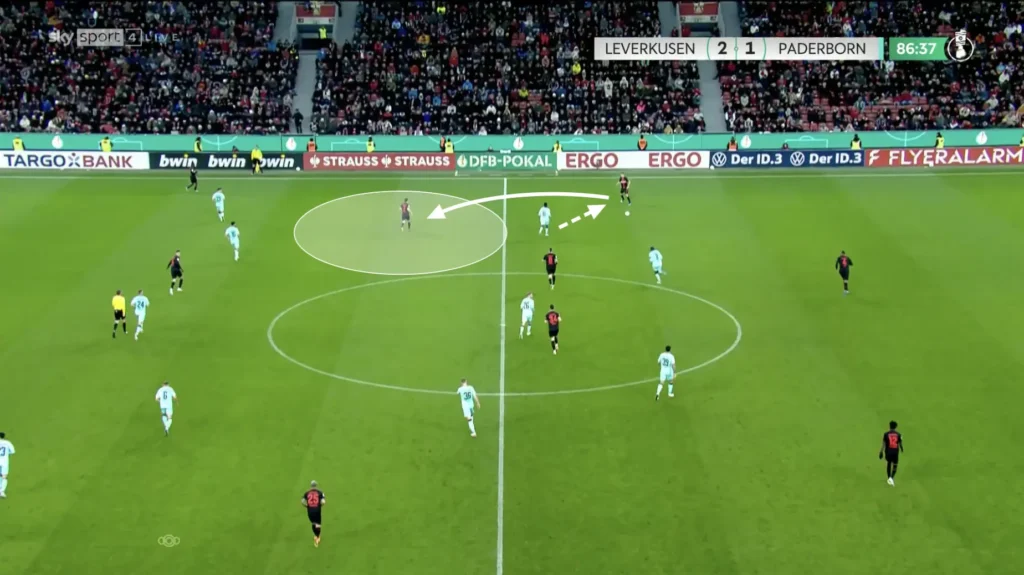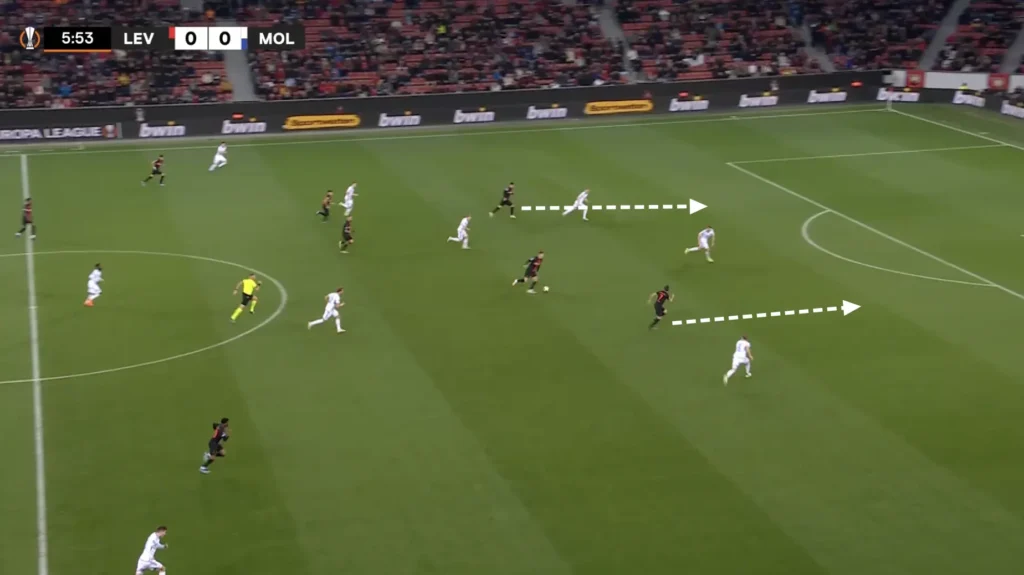In the realm of football tactics, the name Xabi Alonso commands attention. Renowned for his brilliance as a player, Alonso has now transitioned into the role of a tactician, taking charge of Bayer Leverkusen. This article embarks on a comprehensive tactical analysis, dissecting the strategic intricacies employed by Xabi Alonso in steering the fortunes of Bayer Leverkusen. From formations to player movements, join us as we delve into the fascinating world of Alonso’s managerial tactics and their impact on Bayer Leverkusen’s performance on the pitch.
Build-up
Low Build-up
In the low build-up, Leverkusen uses an asymmetrical 1-4-2-3-1 formation with one center forward, one right-winger, two number-tens, and no left-winger.





Building with seven players often results in them having a numerical superiority in their low build-up phase. This allows them to play through the press and progress further up the pitch.
The asymmetrical approach forces Leverkusen to focus on playing on the right side. This obliges the opponent to place a lot of players on the same side to defend accurately. Doing this will, however, open up the left side, often giving massive spaces for Grimaldo on the long switches.

High Build-up
In the high build-up, Alonso changes the formation to a 1-3-2-5:


Alonso likes having only one wide player in the high build-up. This is because he prioritizes playing through the middle. He needs one player high and wide to pull apart the backline. The rest of the players create numerical advantages in the midfield areas, making it easier to find passing combinations. Keeping most players centrally also shortens the length of the passes. This naturally shortens the time between passes, giving the opposition players less time to push up and press. This helps Leverkusen be a possession-based team and allows them to slowly break down the opposition defense.
Another aspect of Leverkusen’s high possession build-up is that they keep a high backline. This helps in the counterpress because they get closer to the center. Having more players close to the center who can win the ball back makes it difficult for the opposition to recycle possession. Furthermore, the high backline shortens the distance between players, shortening the time and length of the passes and preventing the opposition from pushing up their defense.


Leverkusen can sometimes move into a 1-2-3-5 formation, pushing the right center-back into the midfield and dropping out to the left with the left holding midfielder. This creates another element of unpredictability for the opponent and helps them find new ways to beat the line.


Principles and Tools
Xabi Alonso’s Leverkusen always looks to play an attacking and offensive football, regardless of the opposition. They like keeping possession and are often successful in doing so. One influential principle in doing this is to be fluid within the system and to find different rotations. They are extremely fluid, and everyone can play everywhere, even though the formation does not change. Here, Grimaldo comes into the attacking midfield from his left-back position, and the players constantly interchange to cause issues and confusion for the opponents.

Another principle of Leverkusen is to always have an extreme central occupation and can sometimes play with all ten outfield players on the same side.

This gives them excellent conditions in defensive transitions and more options in the build-up, enabling them to keep possession for long periods.
One tool that Leverkusen often uses to beat the opposition’s defense is to follow the pressure from the opposition winger. When the winger goes to press the center-back, a massive space behind him opens up. The ball-side number-ten will occupy that space and receive a pass from the pressured center-back. The opposition’s fullback is pinned by the winger, the central midfielders are pinned by the Leverkusen midfielders, and the center-backs are pinned by the striker, giving the number-ten both space and time to turn and drive at the defense.


Defending
Low Press
In the low press, Xabi Alonso’s Leverkusen uses a 1-5-2-3 formation. They look to set up in a mid-block, always trying to stay compact while closing the center, forcing the opposition out wide. Therefore, they like to play with a high backline, making the space to the midfield line as small as possible.


High Press
Bayer Leverkusen likes to press high when given the opportunity. They do this by going into a man-to-man system, vigorously pressing the opposition in their build-up phase.


Transitions
Positioning many players centrally, creating a numerical advantage in the midfield, creates good conditions in defensive transitions. Many players close to the ball after losing possession means that many players can work towards regaining possession. Leverkusen, therefore, often succeed in regaining possession directly after losing it, allowing them to keep possession for long periods of time.

Because of having a back three, they usually succeed in defending counterattacks as well. They get many players back and favorably protect the center, not allowing the opponent to attack the goal.

Leverkusen also like to counterattack in their offensive transitions. They do this with a high tempo, often attacking the spaces between the center-backs and fullbacks. In addition, having a central front three and two central midfielders enables them to integrate many players in these counterattacks.


Final Thoughts
In conclusion, this tactical analysis of Bayer Leverkusen under the guidance of Xabi Alonso reveals a dynamic and strategic approach that mirrors the footballing intelligence of the legendary midfielder. From a carefully orchestrated build-up to the nuanced defensive schemes, Alonso’s imprint on the team is unmistakable. The adaptability of formations and the emphasis on fluidity showcase a manager who understands the nuances of the modern game.
As Bayer Leverkusen continues its journey under Alonso’s tutelage, the tactical nuances explored in this analysis serve as a testament to the evolving philosophy instilled by the Spanish maestro. For fans and enthusiasts alike, the unfolding chapters of Bayer Leverkusen’s tactical narrative promise an exciting and strategic journey under the guidance of Xabi Alonso.
